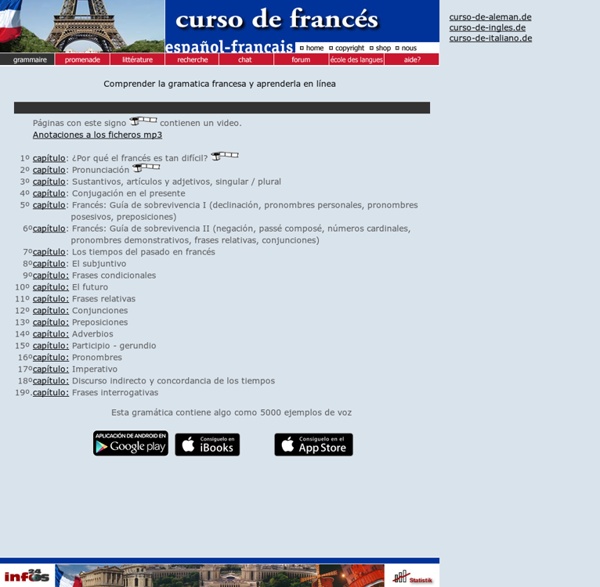FRANCÉS ONLINE
Páginas con este signo contienen un video. Anotaciones a los ficheros mp3 capítulo: ¿Por qué el francés es tan difícil? capítulo: Pronunciación capítulo: Sustantivos, artículos y adjetivos, singular / plural capítulo: Conjugación en el presente capítulo: Francés: Guía de sobrevivencia I (declinación, pronombres personales, pronombres posesivos, preposiciones) capítulo: Francés: Guía de sobrevivencia II (negación, passé composé, números cardinales, pronombres demonstrativos, frases relativas, conjunciones) capítulo: Los tiempos del pasado en francés capítulo: El subjuntivo capítulo: Frases condicionales capítulo: El futuro capítulo: Frases relativas capítulo: Conjunciones capítulo: Preposiciones capítulo: Adverbios capítulo: Participio - gerundio capítulo: Pronombres capítulo: Imperativo capítulo: Discurso indirecto y concordancia de los tiempos capítulo: Frases interrogativas Esta gramática contiene algo como 5000 ejemplos de voz
FRANÇAIS FACILE
Exercices pour apprendre le français
| Cours et exercices de français 100% gratuits, hors abonnement internet auprès d'un fournisseur d'accès.
Guía de pronunciación del francés
Guía de pronunciación del francés Para esta guía, utilizamos los símbolos del alfabeto fonético internacional codificados por Unicode. Si tienes problemas para visualizarlos, revisa la configuración de la codificación de tu navegador. De acuerdo con el uso convencional, usamos la barra oblicua (o slash: //) para indicar la transcripción fonológica de las palabras (ej. /italjɛn/). No se indica el lugar del acento ya que en francés el acento no es léxico, es decir que no se acentúa cada palabra sino que se acentúan grupos de palabras alargando o intensificando la última vocal de todo el grupo. Para la consulta de esta guía, dar clic en las diferentes pestañas según la letra o la primera letra de la grafía de la que se quiere conocer la pronunciación (ej. para saber cómo pronunciar 'eau' buscar en 'e', para las distintas pronunciaciones de la grafía 's' buscar en 's'). Comencemos con el alfabeto francés: "a", "â" /ɑ/ bas : /bɑ/ pâte: /pɑ:t/ "a", "à" /a/ avoir: /avwa:ʁ/ là: /la/ "ai" /ɛ/ mais: /mɛ/
French Vocabulary | Word Lists
"David is clearly a very experienced and knowledgeable teacher. He places emphasis on pronunciation and encourages me to recall my vocabulary in a way that is useful for speaking French day-to-day. His French lessons via Skype are both fun and interesting, and he adapts on-the-fly, so that he can always challenge me at the appropriate level." Maria, Cambridge, UK" Maria, Cambridge, UK "David is a great teacher who cares about his students and makes every effort for them to learn French on Skype where he types lessons notes. "David Issokson is a wonderful French teacher. "It is said that 'The mediocre teacher tells. Learn More About French Skype Lessons
Les temps (French tenses) - Lingolia French
Introduction In this chapter, we will explain how to conjugate verbs in the various tenses. Overview of the Tenses The overview of all the tenses includes an example of each verb group (er/ir/re-verbs) as well as tips on the correct usage of the tenses. Example: tu aimes tu as/avais aimé tu aimais tu aimas tu aimeras Le présent The présent corresponds to the present tense in English. j’aime je finis je vends Le passé composé The passé composé corresponds to the present perfect in English. j’ai aimé/fini/vendu je suis parti L’imparfait The imparfait (continuous past) emphasises the progression or regular repetition of an action in the past. j’aimais je finissais je vendais Le passé récent We use the passé récent to speak about an action that has been completed, shortly before the moment of speaking. Je viens de terminer un livre génial.I have just finished an amazing book.Je venais de sortir quand il s’est mis à pleuvoir.I had just gone out when it started to rain. Le passé simple j’aimai je vendis j’étais parti
French Grammar Exercises
. . . . . . . . . . . . (For information and Copyright notice, click here In French, when speaking in the past tense, one must constantly choose between the imparfait and the passé composé. In this exercise we will focus on the formation and the use of the imparfait versus the passé composé. Main Menu Grammatical Notes Ex. #1 - Vocab.? Ex. #2 - Vocab.? Ex. #3 - Vocab.? Ex. #4 - Vocab.? Ex. #5 - Vocab.? Ex. #6 - Vocab.? Ex. #7 - Vocab.? Ex. #8 - Vocab.? Ex. #9 - Vocab.? Ex. #10 - Vocab.? Top Correct! Proper choice of tense for a description or customary action in the past. The imparfait is generally used for descriptions of circumstances, situation, background, mental and physical states, or for habitual or repeated actions. Back to Ex. 1 Not a valid choice. Improper choice of tense for a description or customary action in the past. Try again. Explanations? Improper choice of auxilary with a reflexive verb. Explanations? Improper choice of tense for refering to a completed action in the past. Explanations? Ex. 5
PHONETIQUE Apprendre à prononcer le français
Learn French For Free.
Related:
Related:



